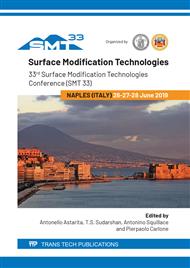p.31
p.37
p.43
p.49
p.55
p.62
p.68
p.74
p.80
Experimental Study of Laser Texturing Processes on the Lubricant Retention of Carbide (WC-Co) Surfaces
Abstract:
Machining process usually involves relevant wear effects on the cutting tool, producing undesirable surface features on the work-pieces. Lubricants and cooling fluids are used with the aim to minimize the wear phenomena as well as high temperatures produced during the cutting processes. However, the use of these fluids may have an adverse environmental impact. For this reason, the reduction of quantity of cutting fluids used in the machining process is a requirement in order to improve the performance and sustainability of the process. For this purpose, this work proposes an increase of the lubricant retention ability for cutting tools based on surface modification. In this research, micro-geometrical features of Carbide (WC-Co) surfaces have been modified by laser texturing techniques. A wide range of roughness topographies had been developed by changing the laser irradiation parameters of energy density of pulse (Ed) and scanning speed of the beam (Vs). Different geometries of the textured tracks (single spots, linear tracks, circular tracks) also were studied. Moreover, through specific roughness features conducted by texturing process, the retention ability of cutting fluids was modified. It was evaluated by the contact angle between liquid and solid phases. This modification allowed to increase the self-lubricant effect of the WC-Co surface. This methodology has been validated on carbide tools under lubricated machining processes. Wear effects on the cutting tool were reduced and the surface finish of the machined parts was remained at least in the same ranges as non-modified tools.
Info:
Periodical:
Pages:
55-61
Citation:
Online since:
July 2019
Price:
Сopyright:
© 2019 Trans Tech Publications Ltd. All Rights Reserved
Share:
Citation:


